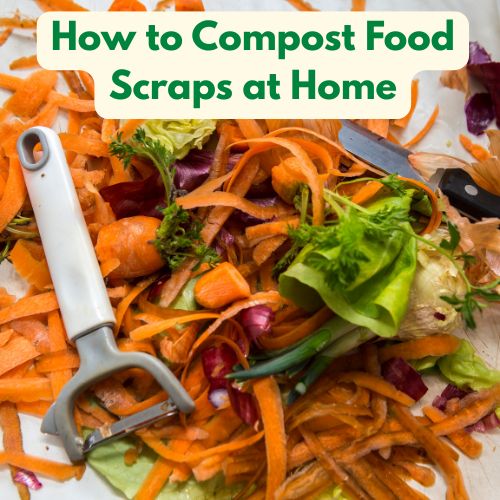How to Compost Food Scraps at Home: A Fun, Earth-Loving Adventure
Hey there, eco-warriors and kitchen rebels! Let’s talk about something that’s equal parts cool, sustainable, and downright satisfying: How to Compost Food Scraps at Home.
Yep, you heard me—those banana peels, coffee grounds, and leftover veggie bits don’t have to end up in the trash bin, stinking up your kitchen like last week’s regrets.
Instead, you can turn them into black gold (aka compost) for your garden or houseplants.
And guess what? It’s way easier than you think.
Stick with me, and I’ll walk you through how to compost food scraps at home in a way that’s fun, low-stress, and maybe even a little hilarious.
I’m no scientist—just a regular person who loves good food, hates waste, and occasionally talks to my compost pile like it’s a pet.
If I can do this, you totally can too. Let’s dive in!

Why Composting Food Scraps at Home Rocks
First off, why bother learning how to compost food scraps at home? Well, for starters, it’s like giving Mother Earth a big ol’ high-five.
Food waste in landfills turns into methane—a greenhouse gas that’s basically the Darth Vader of climate change.
By composting, you’re keeping that junk out of the dump and turning it into something useful. Plus, it’s free fertilizer! Who doesn’t love free stuff?
And let’s be real—it’s kind of magical. You toss in some apple cores and eggshells, give it a little love, and boom, a few months later, you’ve got nutrient-rich soil that makes your plants do a happy dance.
It’s like being a kitchen wizard without the pointy hat.
What You’ll Need to Get Started
Good news: you don’t need a PhD in dirt to figure out how to compost food scraps at home. The setup is simple, and you probably already have most of what you need.
Here’s the lowdown:
- A Container: This could be a fancy compost bin or just an old bucket with a lid. I started with a $5 plastic tub from the hardware store—nothing glamorous, but it got the job done.
- Browns and Greens: Fancy terms, huh? “Greens” are your food scraps (think veggie peels, fruit bits, coffee grounds), and “browns” are dry stuff like cardboard, dead leaves, or shredded paper. Aim for a mix of about 3 parts browns to 1 part greens.
- A Spot: Indoors or outdoors, your call. Backyard? Great. Tiny apartment? No problem—there’s a countertop option for you.
- A Cheap Tool Recommendation: If you want to level up, grab a handheld compost aerator (like the one for about $30 on Amazon). It’s a twisty stick that mixes your pile without breaking your back or your budget. Total game-changer.
That’s it! No rocket science, no expensive gear—just you, some scraps, and a little enthusiasm.

How to Compost Food Scraps at Home: The Step-by-Step
Alright, let’s get into the nitty-gritty of how to compost food scraps at home. Don’t worry, I’m keeping this chill and easy to follow. You’ve got this!
Step 1: Pick Your Composting Style
You’ve got options here:
- Outdoor Pile or Bin: Perfect if you’ve got a yard. Toss everything in, mix it up, and let nature do its thing.
- Tumbling Composter: These spinning barrels (around $50-$100) make turning your compost a breeze. I call mine “The Tumbler of Doom”—it’s dramatic and awesome.
- Indoor Bokashi Bin: Tiny space? This Japanese method ferments your scraps in a sealed bucket with special bran. Smells like pickles, not garbage—promise!
- Worm Bin: Vermicomposting with worms is next-level fun. They’re like tiny coworkers who don’t talk back.
Pick what vibes with your life. I started with a basic outdoor bin because I’m lazy and it’s forgiving.
Step 2: Toss in the Good Stuff
Here’s what you can compost:
- Veggie and fruit scraps (peels, cores, mushy leftovers)
- Coffee grounds (filters too!)
- Eggshells (crush ‘em up a bit)
- Bread, rice, pasta (small amounts, no sauce)
What to skip:
- Meat, dairy, or oily stuff (unless you’re doing Bokashi—it can handle it)
- Citrus in big piles (worms hate it, and it slows things down)
Pro tip: Chop big scraps into smaller bits. It’s like pre-chewing for the microbes—gross but effective.
Step 3: Balance the Browns and Greens
Layer your greens (scraps) with browns (dry stuff). Too many greens, and it’ll get slimy and smell like a swamp monster’s armpit.
Too many browns, and it’ll just sit there like a lazy couch potato. Aim for that 3:1 ratio, but don’t stress—eyeballing it works fine.
Step 4: Mix It Up
Every week or so, give your pile a stir with a pitchfork, shovel, or that nifty aerator I mentioned. It’s like fluffing a giant, earthy pillow.
This keeps the air flowing and the decomposition party going.
Step 5: Wait for the Magic
Depending on your setup, compost takes 2-6 months to finish. You’ll know it’s ready when it looks like dark, crumbly soil and smells like a forest after rain.
Patience, grasshopper—it’s worth it.

Tips and Tricks to Nail It
Here are some golden nuggets to make sure you rock at how to compost food scraps at home:
- Keep It Moist: Your pile should feel like a damp sponge—not soggy, not dry. Sprinkle water if it’s too dusty; add browns if it’s a wet mess.
- Hide the Smell: Bury fresh scraps under a layer of browns or soil. No one wants their backyard smelling like a dumpster dive.
- Coffee Can Hack: Stash scraps in an old coffee can under your sink during the day, then dump ‘em in the bin at night. Keeps fruit flies away and your kitchen classy.
- Freeze It: If you’re slow to fill your bin, freeze scraps in a bag. Bonus: no stench, and it breaks down faster later.
- Laugh at Mistakes: Slimy pile? Stinky mess? It happens. Toss in more browns and call it a learning curve. You’re still a compost champ.
Who’s This For? Pretty Much Everyone!
Wondering if how to compost food scraps at home is your jam? Spoiler: it probably is! This is perfect for:
- Garden Geeks: Free fertilizer for your roses or tomatoes? Yes, please.
- Apartment Dwellers: Tiny Bokashi bins or worm setups fit anywhere.
- Eco-Warriors: Reduce waste and feel like a planet-saving superhero.
- Budget Bosses: Why buy compost when you can make it for free?
- Curious Newbies: It’s a fun, low-stakes experiment. Worst case, you’ve got a funny story.
And the best part? It’s so easy. If you can toss leftovers in a bin and stir a pot of spaghetti, you can compost. No green thumb required—just a little curiosity and a willingness to get a tiny bit dirty.
10 FAQs About How to Compost Food Scraps at Home
Got questions? I’ve got answers. Here’s the scoop:
1. Does composting smell bad?
Not if you do it right! Bury scraps and balance your browns—otherwise, yeah, it might smell like a gym sock.
2. Can I compost in an apartment?
Totally! Bokashi or worm bins are small, odor-free, and fit under your sink.
3. What if I don’t have a yard?
No worries—indoor methods work great, or drop your compost at a community garden.
4. How long does it take?
Anywhere from 2 months (tumbler) to 6 months (pile). Faster if you chop scraps and turn it often.
5. Can I compost meat or cheese?
Skip it unless you’re using Bokashi—it attracts pests and stinks in regular bins.
6. Do I need worms?
Nope, but they’re fun and speed things up. Think of them as composting pets.
7. What if it gets slimy?
Too many greens! Add cardboard or leaves and stir. Crisis averted.
8. Can I use the compost right away?
Wait till it’s dark and crumbly—raw compost can burn plants.
9. How much space do I need?
A corner of your yard or a 1×1-foot bin indoors. It’s tiny-house friendly!
10. Is it worth it?
Heck yes! Free soil, less waste, and bragging rights—what’s not to love?
Wrapping It Up: You’re a Composting Rockstar
There you have it—everything you need to know about how to compost food scraps at home. It’s not just a chore; it’s a mini-adventure that makes you feel good inside and out.
You’re saving the planet one potato peel at a time, and that’s pretty darn cool. So grab that coffee can, start collecting scraps, and give it a whirl.
Mess up? Laugh it off and keep going. You’ve got this, and your plants (or your neighbor’s plants) will thank you.
Now, go forth and compost like the eco-legend you are!







